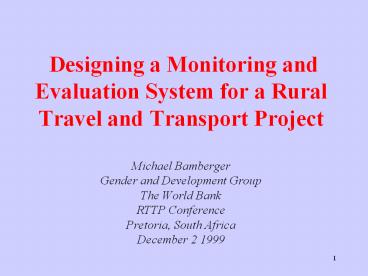Designing a Monitoring and Evaluation System for a Rural Travel and Transport Project Michael Bamberger Gender and Development Group The World Bank RTTP Conference Pretoria, South Africa December 2 1999 - PowerPoint PPT Presentation
1 / 27
Title:
Designing a Monitoring and Evaluation System for a Rural Travel and Transport Project Michael Bamberger Gender and Development Group The World Bank RTTP Conference Pretoria, South Africa December 2 1999
Description:
Evaluation studies and evaluation systems Individual M/E studies can be conducted each using the methods best suited to the particular issue being studied But to ... – PowerPoint PPT presentation
Number of Views:228
Avg rating:3.0/5.0
Title: Designing a Monitoring and Evaluation System for a Rural Travel and Transport Project Michael Bamberger Gender and Development Group The World Bank RTTP Conference Pretoria, South Africa December 2 1999
1
Designing a Monitoring and Evaluation System
for a Rural Travel and Transport Project
Michael BambergerGender and Development
GroupThe World BankRTTP ConferencePretoria,
South AfricaDecember 2 1999
2
A good M/E system helps ensure that a project
- Is being efficiently implemented
- Is reaching the intended target groups
- Is achieving its intended objectives
3
A good M/E system will
- Monitor the use of project inputs
- Monitor the effectiveness of the project
implementation process - Monitor the production of project outputs
- Assess project impacts on the target communities
- Assess the effectiveness of project outputs in
producing the intended short-term and long-term
impacts. - Assess the extent to which these impacts can be
attributed to the effects of the project.
4
An RTT M/E system should
- Extract lessons and best practices for the design
of future projects - Provide guidelines for the modification of
project design - Provide adequate data for the evaluation of
program impact
5
The Basic Monitoring and Evaluation Model
6
(No Transcript)
7
Stages of the project cycle covered by the M/E
system
- Project planning and inputs
- Implementation process
- Output
- Short and long term impacts
- Project sustainability
8
Project implementation and impacts are also
affected by
- The organizational and institutional context
- The economic and political context
- The social and economic characteristics of the
communities
9
(No Transcript)
10
Key questions for designing a M/E system
- What indicators should be used to measure and
monitor each stage of the project? - How should the information be collected?
- How to measure quality and effectiveness?
- How and when to communicate findings to managers
and stakeholders?
11
Key questions continued.
- How do we assess the benefits and impacts
produced by the project? - How to assess whether pilot projects have been
successful.
12
Developing and using indicatorsGood indicators
should
- Cover all stages of the project cycle
- Provide essential information needed to monitor
progress, identify problems and assess results - Provide information which can easily be used by
managers and policy makers - Be objective and easily measurable
- Include the minimum number possible
13
Examples of indicators for a feeder road project
- Planning and inputs
- Implementation process
- Outputs
- Stakeholder groups consulted
- Funds approved and available
- Equipment available
- All community included in planning and
implementation - Targets set for women representatives
- Local organizations established at district level
- Km. Roads constructed/ upgraded
14
Feeder road indicators page 2
- Impacts
- Increased household income
- Higher proportion of girls attending school
- Increased agricultural production
- Wider range of goods available in villages
15
Feeder road indicators page 3
- Sustainability
- Cash payments for road maintenance
- Community labor for road maintenance
- Condition of roads 1, 2 and 5 years after
construction
16
M/E systems must identify all stakeholders and
ensure their information needs are covered.
- All community groups affected by the project
- Local government agencies
- National government agencies
- NGOs
- International development agencies
17
Evaluationstudies andevaluation systems
18
Individual M/E studies can be conducted each
using the methods best suited to the particular
issue being studied
19
But to assess the overall progress of a program
involving many different activities .
- An evaluation system is required
20
Logical framework analysis LOGFRAME
- Is one of the best methods for setting up a
monitoring and evaluation system
21
LOGFRAME helps define the basic assumptions on
which the project design and implementation
systems are based.
22
LOGFRAME monitors the following logical
sequence of activities
23
Ifcertain inputs are used effectivelythencerta
in outputs will be producedif the outputs are
producedthencertain impacts will be achieved
24
ExampleUsing LOGFRAME to monitor and evaluate
the impacts of a feeder road on women
25
If feeder roads are upgradedthenwomen will
take more agricultural produce to
marketthenhousehold income will increaseand
womens economic status will improve
26
Main kinds of M/E studiesSee Handout Annex I for
details
- Question
- Are RTTP activities being implemented on
schedule? - Are women fully involved in all stages?
- Are the activities producing their intended
benefits?
- Study
- Monitoring study
- Gender responsiveness assessment study
- Impact evaluation
27
Main kinds of studies page 2
- Question
- Are the activities sustainable?
- Were the pilot interventions successful and could
they be replicated?
- Study
- Sustainability assessment
- Replicability assessment































